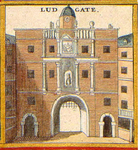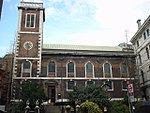Blackfriars Theatre

Blackfriars Theatre was the name given to two separate theatres located in the former Blackfriars Dominican priory in the City of London during the Renaissance. The first theatre began as a venue for the Children of the Chapel Royal, child actors associated with the Queen's chapel choirs, and who from 1576 to 1584 staged plays in the vast hall of the former monastery. The second theatre dates from the purchase of the upper part of the priory and another building by James Burbage in 1596, which included the Parliament Chamber on the upper floor that was converted into the playhouse. The Children of the Chapel played in the theatre beginning in the autumn of 1600 until the King's Men took over in 1608. They successfully used it as their winter playhouse until all the theatres were closed in 1642 when the English Civil War began.
Excerpt from the Wikipedia article Blackfriars Theatre (License: CC BY-SA 3.0, Authors, Images).Blackfriars Theatre
Queen Victoria Street, City of London
Geographical coordinates (GPS) Address Nearby Places Show on map
Geographical coordinates (GPS)
| Latitude | Longitude |
|---|---|
| N 51.512777777778 ° | E -0.1025 ° |
Address
Bank of New York Mellon
Queen Victoria Street 160
EC4V 4BY City of London
England, United Kingdom
Open on Google Maps









